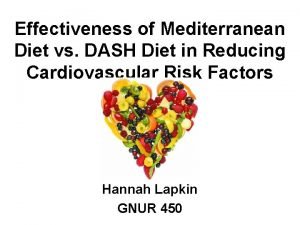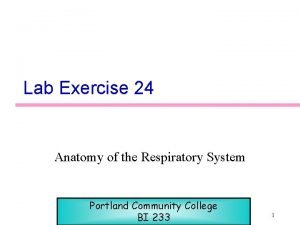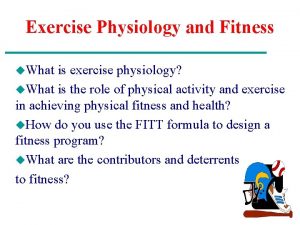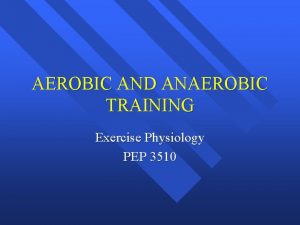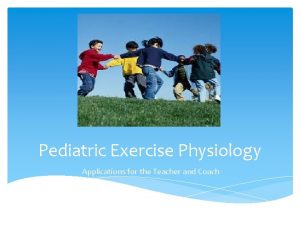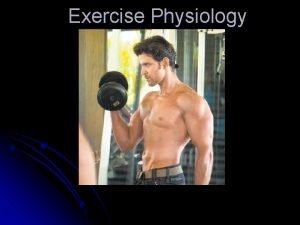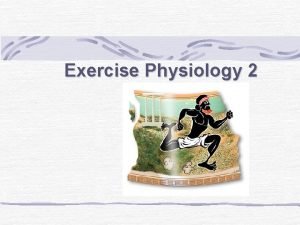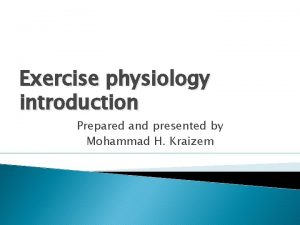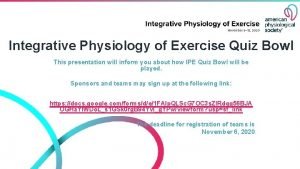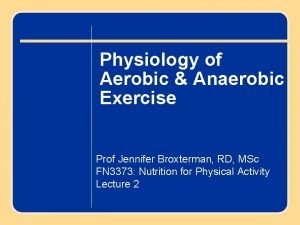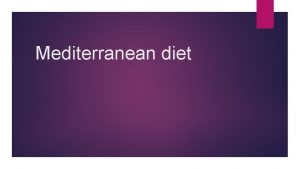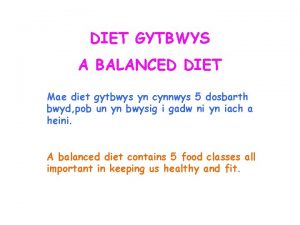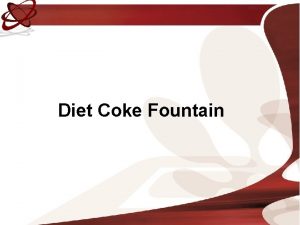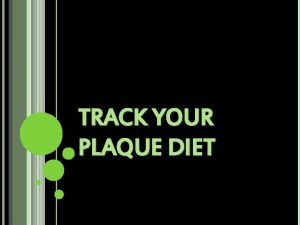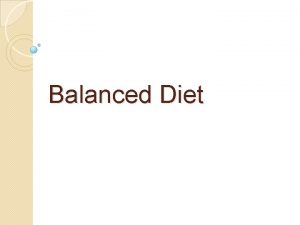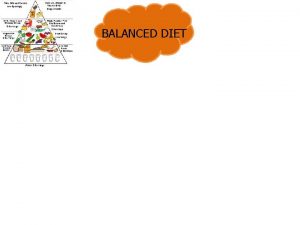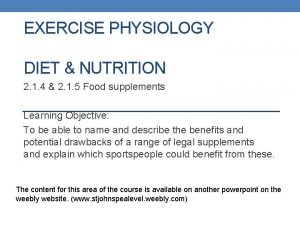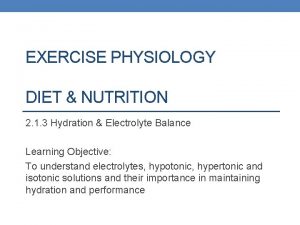EXERCISE PHYSIOLOGY DIET NUTRITION 2 1 1 Nutrition












- Slides: 12

EXERCISE PHYSIOLOGY DIET & NUTRITION 2. 1. 1 Nutrition & Dietary Manipulation Learning Objective: To understand how dietary manipulation can improve performance pre-, during and post-physical activity.

Complete the following table for the nutrients of a balanced diet. NUTRIENT SOURCES Carbohydrate Eggs, Meat, Cheese, Nuts FUNCTION (USE TO US) % OF BALANCED DIET

Macronutrients Complete the following table for the nutrients of a balanced diet. NUTRIENT SOURCES FUNCTION (USE TO US) % OF BALANCED DIET Carbohydrate Sugars, rice, potatoes, pasta. Main energy source / absorbed as glucose / available for immediate energy / excess stored as glycogen (in muscles and liver) and fat. 60 Fats Protein Secondary energy supply / absorbed as fatty acids and Butter, oil, pastry, glycerol / stored as triglycerides. Delayed (20 min) energy fried food. supply during low intensity, long duration activity. Eggs, Meat, Cheese, Nuts Micronutrients Vitamins Minerals Fibre Water Wholegrain, cereals, vegetables. 20 -25 Absorbed as amino acids / used for growth and repair / used as energy source when carbohydrate and fat stores are depleted. 10 -15 Organic substances needed for essential bodily functions. small amounts essential Calcium provides structure for bones and teeth. Iron is needed for red blood cell production. small amounts essential Only available from plant sources / gives bulk to food 20 to 40 grams residues in the intestines / aids gastrointestinal per day functioning. makes up 72% of muscle weight and 50% of adipose Up to 5 litres tissue / used for transportation in our body & lubricates per day joints.

Specific Diets A balanced diet is a very general rule and isn’t specific to most people. The reality is that dietary requirements depend on the duration of exercise, as well as the intensity of exercise. This means developing a diet that is tailor-made to the specific needs of an individual. England Rugby Diet

Carbohydrates • Glycogen is the most valuable food for exercise. • Physically active individuals should obtain 60 -70% of energy intake from carbohydrates, particularly unrefined, low glycaemic foods fresh acidic fruits and most vegetables. • The longer the duration of physical activity the higher % carbohydrate intake. • After exercise we need to replenish carbohydrates. This is best achieved by consuming high glycaemic foods such as bananas, brown rice, pasta, raisins and wholemeal bread. Glycaemic index and glycaemic load

Glycaemic Index and Glycaemic Load Green = Low Glycaemic Index Types of Food Orange = Medium = High Serving size Red Glycaemic Load Net carbs Potato chips 54 114 g 55 g 30 Glucose 100 50 g 50 Watermelon 72 154 g 11 g 8 Banana 52 136 g (1 large) 27 g 14 Pasta 42 140 g 38 g 16 Baked potato 85 173 g 33 g 28

Glycaemic Index is the rate at which the glucose from the food is broken down and absorbed. It isn’t about the amount, it’s all about the speed. Glycaemic Load is an estimate of how much a food will affect blood glucose levels. It takes into account a foods Glycaemic index as well as its carbohydrate content. Watermelon is high GI (it is absorbed quickly into the bloodstream) but it is has a low carbohydrate content so it is low GL (it won’t have a big effect on blood glucose levels). Baked potatoes have high GI (it is absorbed quickly into the bloodstream) and have a high carbohydrate content so it is also high GL (it will lead to a large increase in blood glucose levels).

Carbohydrates Foods should be eaten within 2 hours of completing physical activity. (not doing this will slow the recovery process and increase the likelihood of injury or fatigue) Eating high glycaemic foods after activity increases blood glucose levels quickly. this stimulates greater insulin release. this is needed to convert glucose into glycogen. Optimal glycogen replenishment will be advantageous for individuals involved in regular intense activity. Can you think of a sportsperson who would be required to compete every other day, or sometimes daily, in high intensity, possibly long duration activity?

The main man! 7 matches in a 14 day period to win Wimbledon 2016! He would have to replenish glycogen stores after each match to ensure he has sufficient energy supplies for the next round.

Protein • Physically active people need more protein than inactive people. • 1. 2 -1. 4 grams per kg body mass per day. • Additional protein is required to compensate for muscle breakdown that occurs during and after intense exercise. • Protein is also needed to build new muscle cells (muscular hypertrophy). So an individual trying to increase muscle mass would have their diet tailored to ensure a high protein intake. • In strength and power-based activities, even more protein intake is recommended 1. 4 -1. 8 g / kg mass / day.

Eating before exercise • Food should be eaten 3 -4 hours before activity so that it is well digested and absorbed into the bloodstream. • It should be high in carbohydrates, low in fat and moderate in fibre to assist the digestive process. • An example meal could be pasta bake with spinach, a banana and a still flavoured drink.

Explain the changes an athlete should consider making to their diet during preparation for a marathon run. (5) A linked explanation which makes reference to any of the following points (up to a maximum of five marks). • Increase carbohydrate consumption to enhance glycogen stores (1). • Electrolyte intake to prevent/offset dehydration (1). • Timing of last meal before performance to ensure maintenance of blood glucose (1) and enough time for digestion (1). • Consume enough water to ensure hydration at start of race (1). A maximum of 2 marks for non-linked statements.
 Mediterranean diet vs dash diet
Mediterranean diet vs dash diet Respiratory tree
Respiratory tree Cardiovascular endurance frequency
Cardiovascular endurance frequency Anaerobic exercise physiology
Anaerobic exercise physiology Pediatric exercise physiology
Pediatric exercise physiology Co = map/tpr
Co = map/tpr 2 types of exercise
2 types of exercise Physiology of sport and exercise 5th edition
Physiology of sport and exercise 5th edition Define exercise physiology
Define exercise physiology Myeloma uk forum
Myeloma uk forum Exercise physiology quiz
Exercise physiology quiz Exercise physiology for health, fitness, and performance
Exercise physiology for health, fitness, and performance S2atp
S2atp
